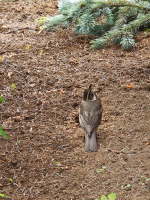A 14 night Cruise from Southampton to Norway and Iceland, 22/6/23 to 6/7/23.
An interesting itinerary on the Arcadia, a P and O adult only cruise ship.
We enjoyed calm seas for most of the voyage with the temperature varying from 3 degrees Celsius in Isafjordur to a balmy 26 degrees Celsius in Skjolden, Norway.
There were plenty of birds along the way but if you’re also interested in whales, dolphins and porpoises you’ll see them too. The captain would often call them out if he saw anything from the bridge.
First two days at Sea: We spent the first two days heading towards Norway passing through the North Sea. It’s not unusual to find an avian stowaway on board, this voyage was no exception. A Blackbird had taken refuge and spent the next two days with us until it departed to start a new life in Norway.
The first day was the more productive of the two with regular sightings of Northern Gannet, Northern Fulmar, some Guillemot and a few Kittiwake. There were less birds around the second day, mainly Northern Gannet and Northern Fulmar.
Sognefjord: When we woke up the next day we were sailing down Sognefjord, the world's longest navigable fjord, extending more than 200 km inland. If you’ve ever visited the Norwegian fjords you’ll often notice a distinct lack of birdlife which contrasts with the impressive number of birds seen as you emerge along the coast. Mind you, the scenery was sometimes jaw-dropping; it's a case of swings and roundabouts.
Early in the morning we arrived in Skjolden, an attractive village at the head of the fjord. There were lots of lovely walks, fantastic scenery and huge waterfalls but not a great variety of birds. I recorded some Barn Swallow, Common Swift, Nuthatch, Barn Swallow, Great Tit, House Sparrow, Pied Wagtail
We left early evening to enjoy the reverse journey down the fjord heading towards Alesund.
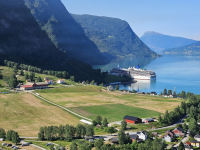
Skjolden: Our first port of call
Alesund: It was worth getting up early to watch the sail-in to Alesund which lies on the south west coast of Norway. The coastal scenery is spectacular and there were thousands of birds to be seen. We were sailing past Runde island at some point, apparently a bird nature reserve.
The first of many Puffin and Common Eider which would be seen on the voyage, were soon spotted, along with Northern Gannet, Northern Fulmar, Guillemot, Kittiwake, Lesser Black-Backed Gull and Herring Gull. Some Turnstone were seen on a rocky island and a Rough-legged Buzzard was seen on the way in.
Despite the number of suitable natural habitats for nesting Kittiwakes, a man- made nesting area had been created in the old fishing quarter of Alesund- a few narrow wooden ledges in between a couple of buildings. They’d been taken up by dozens of Kittiwake with several chicks on show.
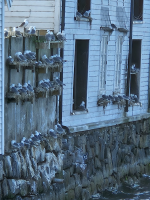
The man-made Kittiwake nests in Alesund.
Sailing towards Iceland: As we left Alesund many of the birds seen on the way in were evidence on the way out. The next morning we were a couple of hundred miles from any land so birds were few and far between save for a solitary Puffin, a few Northern Gannet and Northern Fulmar.
Akureyri: The next morning we were sailing along the spectacular northern coast of Iceland before entering the long fjord at the head of which lies the town of Akureyri.
The first of many Arctic Tern would soon be seen along with the first Arctic Skua of the voyage, there were several more seen on the way in. Black Guillemot and Guillemot were spotted, as well as many Puffin, Northern Fulmar, Lesser Black Backed Gull, Herring Gull, and Black-Headed Gull.
There were scores of Eider Duck many with chicks and and several distant Whooper Swan.
We paid a visit to the impressive botanical garden in the town centre and saw the first of many Redwing. It was interesting to see them on their home territory rather than in the massive flocks we normally associate them with in the UK. There was also a White Wagtail.
If you head towards the airport along the fjord you’ll see a large lake to your right. This was well worth a visit.
Birds seen were, a Slavonian Grebe, 2 Long Tailed Duck, 1 Wigeon, 1 Red Throated Diver, 2 Red Breasted Merganser, 12 Tufted Duck, several Mallard and Eider Duck. An Arctic Skua was seen on the fjord, three Raven and dozens of Eider Duck again, many with young.
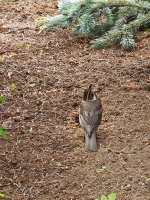
A Redwing on home territory in Iceland.
Isafjordur: We sailed overnight heading towards Isafjordur on the north west coast of Iceland. Once more we woke up to the spectacular coastal scenery Iceland has to offer with its steep cliffs and magnificent waterfalls. There were numerous Arctic Tern, Puffin, Northern Fulmar, several Razorbill, three Northern Gannet and a Cormorant; the only one I saw in Iceland
In the morning we walked behind the town avalanche defences where there was suitable breeding habitat for Black-Tailed Godwit, Common Snipe, Common Redshank and Meadow Pipit all of which were seen. Redwing were common here as well.
In the afternoon we took a stroll along the western edge of the fjord from the town and saw a flock of 60 Razorbill, 1 Black Guillemot and chicks,1 Red Throated Diver, 2 Long Tailed Duck, 6 Red Breasted Merganser, many Common Eider, several with young and a few Mallard.
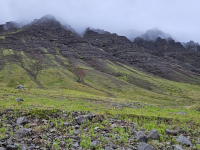
The brooding dramatic landscapes around Isafjordur. Not far from here were the avalanche defences. Common Snipe, Black-tailed Godwit, Meadow Pipit and Common Redshank were around- possibly breeding
Reykjavík: Another excellent early morning sail. Several Arctic Skua were seen along with the usual hordes of Puffin with also many Northern Fulmar and Lesser Black-Backed Gull. There were a number of Arctic Tern, a few Razorbill and Guillemot as well as two Northern Gannet.
If the ship docks at the new cruise terminal, look across and you’ll see Videy Island. Once occupied by a small number of dairy farmers it was abandoned at the beginning of the last century. Now the only buildings are the cafe, a visitor centre and a handful of sheds and toilet blocks. Apparently ‘managed’ by the city authorities it’s been left to go to wreck and ruin, with information boards falling to pieces, rotten boardwalks and footpath signs few and far between. There’s also no obvious evidence of land management for nature, but despite all that it’s absolutely thriving with birds, many of which would appear to be breeding, or attempting to breed. It can easily be reached by an hourly ferry which costs £11 return. They accepted our Monza debit card so there’s no need to pay in local currency.
Birds seen: Northern Fulmar nesting on the cliffs, some with chicks, Lesser Black-Backed Gull and young, Herring Gull, Arctic Tern, Common Snipe, Black-Tailed Godwit, Greylag Goose and young, Common Eider and young, Meadow Pipit, Whimbrel, Common Starling, Oystercatcher, Dunlin, Common Redshank, Pied Wagtail, Common Teal, Mallard.
Apparently Golden Plover is the most common species and Purple Sandpiper the fourth most common, but I saw neither.
The island was absolutely buzzing with the noise and activity of the birds and well worth a visit.
We were in port overnight; the next day we had a look around the city. Right in the middle is a large park area dominated by a stretch of water known as the City Pond. There were Tufted Ducks and chicks, Mallard, Whooper Swan, a pair of Wigeon, and, on a small island, around 20 pairs of Arctic Terns nesting, some with chicks.
There were several Redwing about.
Botanical Gardens: Greylag Goose and chicks, a White Wagtail, Redwing and a Raven overhead.
When you leave and if you’re heading south, the ship will sail west towards Keflavik .Having sailed that way before, I recall seeing thousands of birds on the way out. Tonight was no exception with an abundance of Puffin, Arctic Tern, Razorbill, Guillemot, Lesser Black Backed Gull, and Herring Gull. Also, 1 Northern Gannet, 2 Kittiwake, 3 Black Guillemot, 1 Red Breasted Merganser and 3 Arctic Skua.
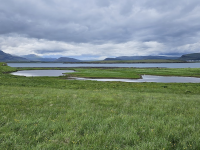
Videy Island, Reykjavik. A lively nature reserve thriving with birds.
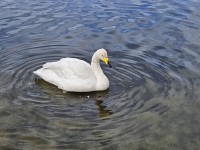
Whooper Swan in the middle of Reykjavik on the City Pond.
Two days at sea heading to Belfast: In the morning we were a long way from any land ;over 200 miles from the Faroes. Despite that the first of the Manx Shearwater of the voyage were seen. Mainly ones and twos except for a larger group of a dozen seen at one stage. The trusty Northern Fulmar put in an appearance with several spotted during the day.
The next day we were getting closer to the western Scottish isles. Manx Shearwater and Northern Fulmar were in evidence and around 50 Northern Gannet were seen. Late in the evening, 2 unidentified storm petrel species flew past the bow of the boat.
Belfast: In the morning we were somewhere between the Northern Ireland coast and the Rhins of Galloway, Scotland. Dozens of Northern Gannet were about, as well as several Manx Shearwater and Northern Fulmar. One Arctic Skua was spotted, the last of the voyage, and 2 Razorbill were seen.
Sailing into Belfast I noticed several Coot, a Lapwing and a lot of waterfowl on the RSPB Belfast Lough Reserve. It’s right next to the cruise dock but didn’t have time to visit.
On leaving I spotted a Black Guillemot and 4 Shag and as we sailed further out there were impressive numbers of Razorbill, Guillemot and Northern Gannet particularly in the area between the Mull of Galloway and the Isle of Man.
Last day at sea: In the morning we were somewhere off St David’s Head, Pembrokeshire heading towards Land’s End. Around 8:00 AM we were obviously passing a bird-rich area when a huge number of Manx Shearwater and Northern Gannet suddenly turned up, the most seen of either species at any particular time during the journey.
Although they tailed off they were seen on and off in lesser numbers during the rest of the day along with some Northern Fulmar, gulls and a few distant auks.
An interesting itinerary on the Arcadia, a P and O adult only cruise ship.
We enjoyed calm seas for most of the voyage with the temperature varying from 3 degrees Celsius in Isafjordur to a balmy 26 degrees Celsius in Skjolden, Norway.
There were plenty of birds along the way but if you’re also interested in whales, dolphins and porpoises you’ll see them too. The captain would often call them out if he saw anything from the bridge.
First two days at Sea: We spent the first two days heading towards Norway passing through the North Sea. It’s not unusual to find an avian stowaway on board, this voyage was no exception. A Blackbird had taken refuge and spent the next two days with us until it departed to start a new life in Norway.
The first day was the more productive of the two with regular sightings of Northern Gannet, Northern Fulmar, some Guillemot and a few Kittiwake. There were less birds around the second day, mainly Northern Gannet and Northern Fulmar.
Sognefjord: When we woke up the next day we were sailing down Sognefjord, the world's longest navigable fjord, extending more than 200 km inland. If you’ve ever visited the Norwegian fjords you’ll often notice a distinct lack of birdlife which contrasts with the impressive number of birds seen as you emerge along the coast. Mind you, the scenery was sometimes jaw-dropping; it's a case of swings and roundabouts.
Early in the morning we arrived in Skjolden, an attractive village at the head of the fjord. There were lots of lovely walks, fantastic scenery and huge waterfalls but not a great variety of birds. I recorded some Barn Swallow, Common Swift, Nuthatch, Barn Swallow, Great Tit, House Sparrow, Pied Wagtail
We left early evening to enjoy the reverse journey down the fjord heading towards Alesund.

Skjolden: Our first port of call
Alesund: It was worth getting up early to watch the sail-in to Alesund which lies on the south west coast of Norway. The coastal scenery is spectacular and there were thousands of birds to be seen. We were sailing past Runde island at some point, apparently a bird nature reserve.
The first of many Puffin and Common Eider which would be seen on the voyage, were soon spotted, along with Northern Gannet, Northern Fulmar, Guillemot, Kittiwake, Lesser Black-Backed Gull and Herring Gull. Some Turnstone were seen on a rocky island and a Rough-legged Buzzard was seen on the way in.
Despite the number of suitable natural habitats for nesting Kittiwakes, a man- made nesting area had been created in the old fishing quarter of Alesund- a few narrow wooden ledges in between a couple of buildings. They’d been taken up by dozens of Kittiwake with several chicks on show.

The man-made Kittiwake nests in Alesund.
Sailing towards Iceland: As we left Alesund many of the birds seen on the way in were evidence on the way out. The next morning we were a couple of hundred miles from any land so birds were few and far between save for a solitary Puffin, a few Northern Gannet and Northern Fulmar.
Akureyri: The next morning we were sailing along the spectacular northern coast of Iceland before entering the long fjord at the head of which lies the town of Akureyri.
The first of many Arctic Tern would soon be seen along with the first Arctic Skua of the voyage, there were several more seen on the way in. Black Guillemot and Guillemot were spotted, as well as many Puffin, Northern Fulmar, Lesser Black Backed Gull, Herring Gull, and Black-Headed Gull.
There were scores of Eider Duck many with chicks and and several distant Whooper Swan.
We paid a visit to the impressive botanical garden in the town centre and saw the first of many Redwing. It was interesting to see them on their home territory rather than in the massive flocks we normally associate them with in the UK. There was also a White Wagtail.
If you head towards the airport along the fjord you’ll see a large lake to your right. This was well worth a visit.
Birds seen were, a Slavonian Grebe, 2 Long Tailed Duck, 1 Wigeon, 1 Red Throated Diver, 2 Red Breasted Merganser, 12 Tufted Duck, several Mallard and Eider Duck. An Arctic Skua was seen on the fjord, three Raven and dozens of Eider Duck again, many with young.

A Redwing on home territory in Iceland.
Isafjordur: We sailed overnight heading towards Isafjordur on the north west coast of Iceland. Once more we woke up to the spectacular coastal scenery Iceland has to offer with its steep cliffs and magnificent waterfalls. There were numerous Arctic Tern, Puffin, Northern Fulmar, several Razorbill, three Northern Gannet and a Cormorant; the only one I saw in Iceland
In the morning we walked behind the town avalanche defences where there was suitable breeding habitat for Black-Tailed Godwit, Common Snipe, Common Redshank and Meadow Pipit all of which were seen. Redwing were common here as well.
In the afternoon we took a stroll along the western edge of the fjord from the town and saw a flock of 60 Razorbill, 1 Black Guillemot and chicks,1 Red Throated Diver, 2 Long Tailed Duck, 6 Red Breasted Merganser, many Common Eider, several with young and a few Mallard.

The brooding dramatic landscapes around Isafjordur. Not far from here were the avalanche defences. Common Snipe, Black-tailed Godwit, Meadow Pipit and Common Redshank were around- possibly breeding
Reykjavík: Another excellent early morning sail. Several Arctic Skua were seen along with the usual hordes of Puffin with also many Northern Fulmar and Lesser Black-Backed Gull. There were a number of Arctic Tern, a few Razorbill and Guillemot as well as two Northern Gannet.
If the ship docks at the new cruise terminal, look across and you’ll see Videy Island. Once occupied by a small number of dairy farmers it was abandoned at the beginning of the last century. Now the only buildings are the cafe, a visitor centre and a handful of sheds and toilet blocks. Apparently ‘managed’ by the city authorities it’s been left to go to wreck and ruin, with information boards falling to pieces, rotten boardwalks and footpath signs few and far between. There’s also no obvious evidence of land management for nature, but despite all that it’s absolutely thriving with birds, many of which would appear to be breeding, or attempting to breed. It can easily be reached by an hourly ferry which costs £11 return. They accepted our Monza debit card so there’s no need to pay in local currency.
Birds seen: Northern Fulmar nesting on the cliffs, some with chicks, Lesser Black-Backed Gull and young, Herring Gull, Arctic Tern, Common Snipe, Black-Tailed Godwit, Greylag Goose and young, Common Eider and young, Meadow Pipit, Whimbrel, Common Starling, Oystercatcher, Dunlin, Common Redshank, Pied Wagtail, Common Teal, Mallard.
Apparently Golden Plover is the most common species and Purple Sandpiper the fourth most common, but I saw neither.
The island was absolutely buzzing with the noise and activity of the birds and well worth a visit.
We were in port overnight; the next day we had a look around the city. Right in the middle is a large park area dominated by a stretch of water known as the City Pond. There were Tufted Ducks and chicks, Mallard, Whooper Swan, a pair of Wigeon, and, on a small island, around 20 pairs of Arctic Terns nesting, some with chicks.
There were several Redwing about.
Botanical Gardens: Greylag Goose and chicks, a White Wagtail, Redwing and a Raven overhead.
When you leave and if you’re heading south, the ship will sail west towards Keflavik .Having sailed that way before, I recall seeing thousands of birds on the way out. Tonight was no exception with an abundance of Puffin, Arctic Tern, Razorbill, Guillemot, Lesser Black Backed Gull, and Herring Gull. Also, 1 Northern Gannet, 2 Kittiwake, 3 Black Guillemot, 1 Red Breasted Merganser and 3 Arctic Skua.

Videy Island, Reykjavik. A lively nature reserve thriving with birds.

Whooper Swan in the middle of Reykjavik on the City Pond.
Two days at sea heading to Belfast: In the morning we were a long way from any land ;over 200 miles from the Faroes. Despite that the first of the Manx Shearwater of the voyage were seen. Mainly ones and twos except for a larger group of a dozen seen at one stage. The trusty Northern Fulmar put in an appearance with several spotted during the day.
The next day we were getting closer to the western Scottish isles. Manx Shearwater and Northern Fulmar were in evidence and around 50 Northern Gannet were seen. Late in the evening, 2 unidentified storm petrel species flew past the bow of the boat.
Belfast: In the morning we were somewhere between the Northern Ireland coast and the Rhins of Galloway, Scotland. Dozens of Northern Gannet were about, as well as several Manx Shearwater and Northern Fulmar. One Arctic Skua was spotted, the last of the voyage, and 2 Razorbill were seen.
Sailing into Belfast I noticed several Coot, a Lapwing and a lot of waterfowl on the RSPB Belfast Lough Reserve. It’s right next to the cruise dock but didn’t have time to visit.
On leaving I spotted a Black Guillemot and 4 Shag and as we sailed further out there were impressive numbers of Razorbill, Guillemot and Northern Gannet particularly in the area between the Mull of Galloway and the Isle of Man.
Last day at sea: In the morning we were somewhere off St David’s Head, Pembrokeshire heading towards Land’s End. Around 8:00 AM we were obviously passing a bird-rich area when a huge number of Manx Shearwater and Northern Gannet suddenly turned up, the most seen of either species at any particular time during the journey.
Although they tailed off they were seen on and off in lesser numbers during the rest of the day along with some Northern Fulmar, gulls and a few distant auks.
Attachments
Last edited:





